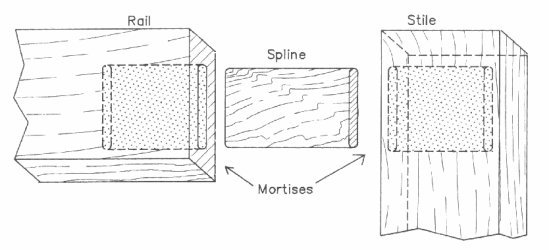|
A Treatise on construction methods and material selection
for Craftsman & Mission style doors
Doors are the opening statement of every home.
They are the first and last thing we all see and touch as we
enter or leave a home. The quality and beauty of these doors set the
tone for the rest of the home. This is particularly true in a Craftsman
or Mission style home. In these homes
the visible integrity of the woodwork is of paramount importance. No other
item in the home sees more use or is subjected to more abuse. The architects
and home builders of the Craftsman Era understood this and responded by
furnishing these homes with some truly timeless, traditionally constructed
solid lumber doors. The term "Built to Last" really meant something as is
witnessed by the thousands of these homes which are lovingly restored and
cherished by their present day owners.
Today we are experiencing a renewed interest in the home designs of the
Craftsman Movement. Some of these newly constructed homes are honest examples
of craftsmanship and feature careful use of appropriate materials and details.
As might be expected many of the new Craftsman style homes being built today
fall short of the properties and characteristics which made the authentic
homes so exceptional. I believe that this is due to a lack of understanding
of what qualities actually constitute a real Craftsman home. To truly grasp
this one
must examine the difference between "styled products" and products which
actually feature authentic design and construction.
For literally hundreds of years doors constructed with mortise
& tenon joinery were considered to be among the finest and longest lasting
doors available. In the middle of the last century mass produced housing
projects began to take form. With this came the regular use of unskilled
labor and building to the "bottom line". As a result the traditional trades
began to die off. And along with this many of the
time honored construction skills which had proven effective for centuries.
This period heralded the phenomenon of "disposable hardgoods". Suddenly
it became accepted practice to furnish and install products which had a
much shorter life span than
the home they were being put into. To make matters worse much
of the materials chosen for these applications were selected based only
on a cost effectiveness basis. Little or no
thought was given to longevity or sustain ability. Doors, windows, cabinetry
and trim were all heavily subjected to this treatment. And most homeowners
are all too familiar
with the down side of this equation. Aside from the very real economic
issues involved with early replacement of these items, it should be quite
obvious to all that continuing
this practice results in a shameful waste of natural resources.
Heart of Oak Workshop Door Materials
Our doors are always constructed using premium grades
of solid lumber.
No fragile veneers to damage and nothing to delaminate.
Each piece of lumber is hand selected to insure that our customer receives
the very best that Mother Nature has to offer. Years of experience allows
me to confidently select only
the most suitable boards for each door. And we offer only species
that have appropriate characteristics for door construction. Woods like White
Oak, Mahogany
& Vertical Grain Douglas Fir to name a few. Wood that has a high
degree of structural integrity and resistance to decay.
Figure, straightness and density are just a few of the factors to be
considered. After the wood has been selected it is then carefully milled
to rough size and then allowed to "season".
This is basically a stabilization period. Cutting and milling by it's very
nature often releases tension from within a board caused during the drying
process. Most of the time if there is going to be a negative reaction this
change takes place immediately. But it is prudent to allow a week or two
for this to occur. The amount of time necessary for stabilization varies
from species to species and sometimes board to board. This process
is often overlooked by less experienced woodworkers and is absolutely critical
to the final integrity of a solid lumber door.
No veneers, finger jointed cores or composites are ever
used in the construction of our doors.
The use of these so called "engineered wood" products is extremely
prevalent in doors being manufactured this time. Many cleverly worded marketing
schemes would have the
potential buyer believing that this is actually a better way to construct
doors. Well it is.....as far as the manufacturer is concerned. It
is without question cheaper and easier to
construct with. With a fair amount of effort it can even be made to look
quite natural and attractive. I can't help wondering if this isn't the ultimate
in irony. Spending time and money on disguising the truth when the real
thing will easily outlast the fake.
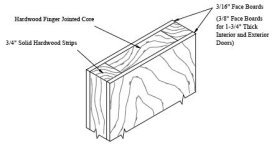 An example of one form of composite material
An example of one form of composite material
Some of the better manufacturers of composite wood doors actually go
to great lengths to assure that their customers get a product that is a
fair value for the initial purchase price. Others simply slap it together
and hope it lasts the term of the warranty. Either way it should be obvious
that this type of material will most likely have a much shorter service
life
than a good quality and properly constructed solid lumber door.
We do realize that the initial cost of
the type of product we offer cannot always be rationalized. In the case
of our solid lumber, mortise & tenon door the cost of material
generally
runs 35% to 45% of the total sale cost. As you might imagine this is radically
different from manufactured composite doors. Here a number like 10% to 15%
of the overall cost is much more likely. So yes a composite door is likely
to have a lower initial cost......but how many times will it need to be
replaced during the life of the home? And how does it fit in with the basic
principals of the Arts & Crafts Movement which is firmly anchored in
the use of honest materials and craftsmanship.
Most certainly there are some conditions such as extreme weather
exposure where a wood door of any type is not always the most appropriate
solution. If you are faced with this
situation we would like to urge you to consider a high quality fiberglass
or metal door as a responsible alternative to purchasing a composite wood
door.
Heart of Oak Workshop Door Construction Techniques
It should be obvious to the reader by now that I am completely biased
towards the use of Mortise and Tenon joinery for the construction of doors.
This can be attributed to the simple
fact that I enjoy building these doors and I intend them to last
long after I am gone. I truly appreciate the opportunity to be working with
fine woods and continually strive to build the very best doors available.
As a responsible craftsperson I feel that it is my duty to see that the
doors I create have the longest possible service life. My customers
and the wood that I use deserve nothing less.
The doors I make are my legacy and I do not employ any of the joinery compromises
that others may have accepted as adequate.
Over the years I have conducted rigorous testing and experimentation
focused on the causes and prevention of joint failure. The end result is
that I have no doubt at all that a
properly assembled mortise & tenon joint will out last any other method
of wooden door construction. I am so confident that this is true that I
offer all my customers a
Unconditional Warranty against joint
failure on all the doors I build. It is all in the mechanics of this joint
and how well it is executed. Please read the sections below. I believe
you
will agree.
True Haunched Mortise & Tenon
Joint
Shown : An actual example of Stile & Head Rail joint
on one of our Classic Craftsman doors.
Please note that the tenon is an actual integrated element of the rail.
Length of tenon is 2 3/4".
Photo of dry fit prior to actual assembly.
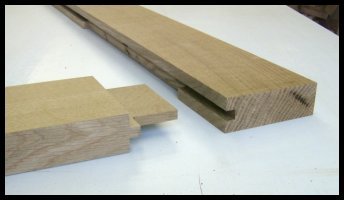
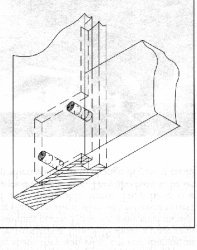
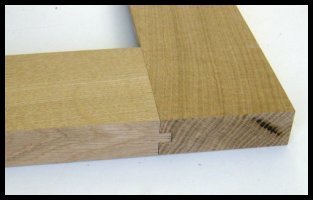
All of our doors feature haunched mortise & tenons which
are glued and mechanically locked in place with pegs. This joint
is clearly mechanically superior to all others in this application and completely
resists the racking action that all door joints are subject to. It is the
only joint that will hold together just fine without glue. It features a
massive integrated tenon which extends into the mortise for half the width
of the stile.
The primary reason that this method of joinery is not seen more often
in recently made doors is that it is very labor intensive and requires specialized
tools and skills to execute properly. Hand fit up is required and this should
always be performed by an experienced joiner. I personally perform
this task on each and every door made at Heart of Oak Workshop.
I use properly set up square chisel mortisers which do not burnish the
mating surfaces of the mortise.
In addition I use special tooling to saw cut the tenons. Here again no
burnishing is created in this process. This sort of attention to detail
is what sets our doors apart from most others. These joints are totally
bulletproof. I have done it this way for many years and have literally made
thousands of these joints. And not once has one failed.
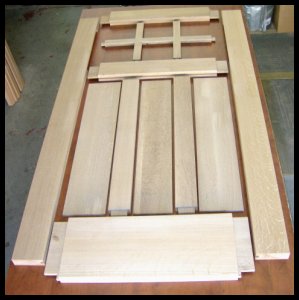
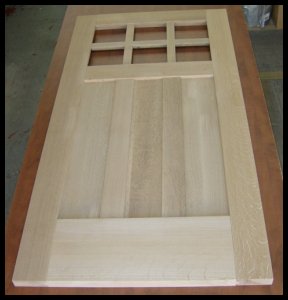
A Classic Craftsman Entry door being dry
fit prior to assembly
This is truly the only method of joinery that combines
all of the characteristics necessary to stand up to decade after decade
of use without possibility of failure. Since we offer a unconditional warranty
against joint failure we have taken the added precaution of using a high
quality waterproof glue on all our doors. After all why not take advantage
of the
largest and best shaped glue surface of all of the various door making
joints.
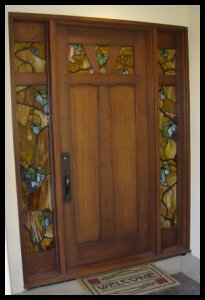 A Greene & Greene inspired Entry System by Heart
of Oak Workshop
A Greene & Greene inspired Entry System by Heart
of Oak Workshop
All of the
other methods of joinery used to make the critical rail to stile joint get
the bulk of their strength from the glue that is used. And if for any reason
the glue fails then so does the joint. This is clearly not the case
with our method of construction.
Other commonly employed door construction joints
include:
Doweled Butt Joint
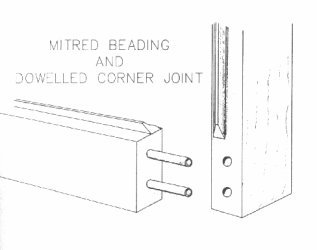
This is a "butt" type joint of end grain to edge grain which
is reinforced with wood dowels. It is a very easily assembled joint. It is
totally reliant on the bonding strength of the glue used. To make matters
worse the working surface area of the bond is quite small. End grain to edge
grain has almost no bonding qualities. Any resistance to separation and racking
it does have is centered on the glue surface of the dowels themselves. It
doesn't take too much imagination ( or real life experience ) to picture
the eventual outcome here. It almost always ends badly.
A recent episode of "This Old House" featured a segment of Norm Abrams
and his approach to the repair of this type of joint. In a nutshell the
door was completely disassembled and
the failed glue surfaces were cleaned and re-glued. Then he drilled
for and added huge lag bolts to help prevent future separation. The heads
of the lag bolts where cleverly hidden in a recess covered with a wooden
plug. I got a good chuckle from this whole operation as it was so obviously
not the first time he had made this type of repair.
This joint has a well documented history of early failure and in my opinion
should never be used to construct exterior doors.
One further note to the wise. I have seen many fairly high
priced custom doors made using this method of joinery. It truly boggles
the mind to consider why otherwise intelligent consumers would pay high
prices for this type of joinery. I suppose the old catch phrase " Out of
sight, Out of mind" applies here.
Cope & Stick Joint
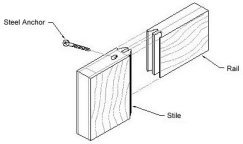
Variations of this joint are commonly seen in mass
produced doors. It is made using high speed machinery and is easily
assembled using unskilled labor. In it's basic form it is a fair joint to
use for smaller framed components like cabinet doors or windows. It has
a relatively small glue surface area and is indexed in one plane by mating
profiles. It is often nailed or screwed in place to resist racking during
glue up. Another form of this joint used for door making features the addition
of dowels as reinforcement. This should tell you something.
It may be adequate for lightweight interior doors but should never
be considered for exterior applications as it is prone to the same failings
as all dowel based joints.
A slightly better form of this joint is employed in some higher quality
products. This version has a relatively short (5/8" to 1 1/16") stub tenon
which increases the glue surface area and helps to better index the rail
to stile joint. It is what I refer to as a "50%er". By comparison our
doors feature 2 3/4" long tenons which offer more than two times
the glue surface area. What this all means is if a cope and stick door is
well executed it is going to do fairly well for a while. Maybe 10 years
or so. If it is well executed....if everything fits properly and it received
the correct amount of glue and the finish is not allowed to fail.
Floating or Loose Tenon Joint
The term Tenon here is really a misnomer. Tenon
implies that it is an integrated
structural element of the rail. While it functions similarly to a true
tenon it is
clearly a separate piece and should be referred to as a spline.
On the surface this would seem to be the best of the compromise
joints listed here. This is a method of joinery which I have experimented
with as it appeared to offer good characteristics. If it is properly constructed
& assembled and mechanically pegged on both ends it offers almost as
much strength as a true mortise and tenon joint. It should be noted that
most of these don't actually get pegged and then it is down to the glue bond
to hold things together. Unfortunately quite a lot can go wrong with this
joint during fit up and assembly. Something you won't find out until it is
too late.
My testing indicates that glue starvation is a big issue here. Beyond
that many manufacturers mill the separate "tenon" improperly or make it from
the wrong material. Additionally the mortises in this application are almost
always made with a router or slot mortiser and the resulting mating surface
is burnished to a
degree that a weak glue bond can result. Anyone who has ever actually
routed mortises in end grain (such as the mortise in the rail shown
above) will confirm this.
My evaluation of this method is that under the very best of circumstances
this might be an acceptable door joint. I suppose that I would trust them
if I had the opportunity to watch the door being made and be able to verify
that all the necessary conditions have been met. Otherwise .... well I think
I would have to pass as I am all too aware of what can go wrong with this
joint.
I hope you have found this write up useful.
Jeff Balazs, Owner, Designer / Craftsman, Heart of Oak Workshop
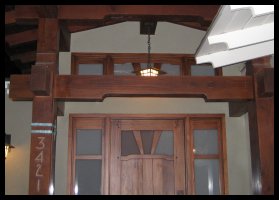 Another G & G inspired Entry System by Heart
of Oak Workshop
Another G & G inspired Entry System by Heart
of Oak Workshop
FLW
* CFA Voysey * Mackintosh * Mackmurdo * Ellis * Gill * Ashbee
|











